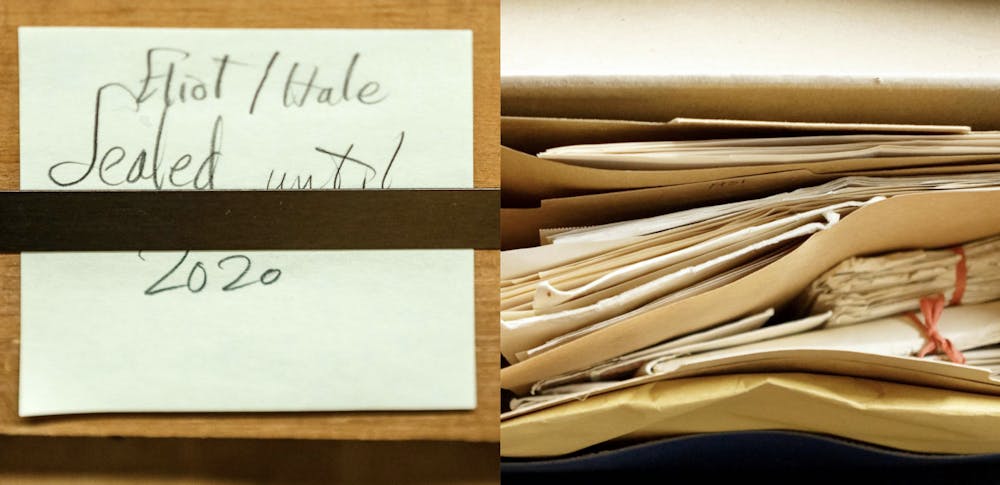On Jan. 2, a collection of 1,131 letters written by renowned poet and Nobel Laureate Thomas Stearns Eliot, better known as T.S. Eliot, opened for research at Firestone Library. Eliot sent the letters, drafted between 1932 and 1947, to Emily Hale, his muse and lover.
In the week prior to the letters’ release, associate professor of English Joshua Kotin said they were “already generating excitement on campus.”
“Students who have been fascinated by ‘The Love Song of J. Alfred Prufrock’ (1915) and ‘The Waste Land’ (1922) are now asking questions about Eliot himself,” he said in a press release.
Hale donated the letters to Princeton in November 1956. According to the University statement, English professor Willard Thorp GS ’26 “played an essential role in Hale’s donation” to the University.
The letters, which were not to be opened until 50 years after Eliot and Hale’s deaths, were formerly among the most well-known sealed literary archives in the world.
Prior to the opening of the letters, scholars were uncertain about the extent of Eliot’s relationship with Hale, which occurred while Eliot was married to Vivienne Haigh-Wood. In a statement accompanying the letters, Eliot gave some context.
“I never at any time had any sexual relations with Emily Hale,” he wrote. “Upon the death of Vivienne in the winter of 1947, I suddenly realised that I was not in love with Emily Hale. Gradually I came to see that I had been in love only with a memory, with the memory of the experience of having been in love with her in my youth.”
Although Eliot’s statement asserts that his feelings for Hale were ambivalent, his letters tell a more straightforward story.

University of Missouri Professor Frances Dickey read the letters when they were released on Thursday, according to The Washington Post.
“In the first two letters,” Dickey said in the interview, “He basically confesses his love for Emily Hale and tells her that she’s the great love of his life, that he’s been writing for her all of these years.”
Dickey added that the letters also revealed places in Eliot’s poetry where he paid tribute to Hale.
For instance, scholars had previously theorized that the “hyacinth lines” in “The Waste Land” alluded to one of his personal relationships. This was confirmed by one of Eliot’s letters to Hale, in which he told her to reread the lines:

“You gave me hyacinths first a year ago;/‘They called me the hyacinth girl.’/—Yet when we came back, late, from the Hyacinth garden,/Your arms full, and your hair wet, I could not/Speak, and my eyes failed, I was neither/Living nor dead, and I knew nothing,/Looking into the heart of light, the silence. Oed’ und leer das Meer.”
The relationship between Eliot’s personal life and poetry is one reason why Kotin wants to take his students to Firestone Library to study the letters.
“The visit will be an incredible opportunity to test the importance of Eliot’s famous claim about poetry and personality. ‘Poetry,’ he wrote in ‘The Tradition and the Individual Talent’ (1919), ‘is not the expression of personality, but an escape from personality.’ The letters will, I hope, allow students to judge how effectively Eliot escaped his own personality,” Kotin said in the University statement.
In addition to seeing how his personality informed his poetry, some people believe that the letters might show how Eliot’s poetry reflects his conversion to the Anglican church and his search for meaning in a war-torn world.
William Speers ’79, who wrote his thesis on Eliot’s work, noted that the poet wrote his letters during difficult periods of his life.
“Eliot was in a really brutal marriage. His wife had huge nervous breakdowns. He had breakdowns,” Speers said. “I think part of what may be seen in these letters is somebody who was definitely searching and was struggling and trying to find some meaning to the world around him.”
Eliot’s letters to Hale were more personal and reflective than other correspondences he maintained.
“A friend once wrote that ‘Tom was more human’ in America than he was in England, and Emily Hale was an important part of this mode of being. He was also, it seems, rather afraid of being human, and perhaps we shall learn something more about this from the letters, as well as about many interesting literary matters,” said Michael Wood, the Charles Barnwell Straut Class of 1923 Professor of English and Comparative Literature, Emeritus, in the University statement.
Though the letters may shed insight into how Eliot thought of Hale, her responses will remain unknown.
Eliot wrote in an addendum to his statement, dated Sept. 30, 1963, “The letters to me from Emily Hale have been destroyed by a colleague at my request.”








